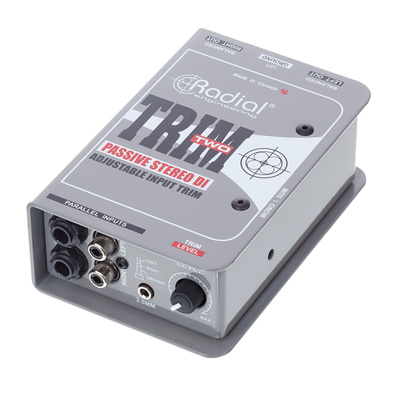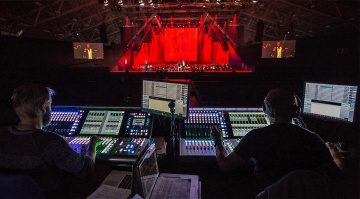The Live Sound Engineer Tool Box: All the Essentials
Never leave home without it.
Want to make sound gigs a full-time job? We explore the Live Sound Engineer Tool Box, a guide with gear and tips to help you get started.
In this Article:
If you are considering making a career out of sound engineering, there are a few tips that can help you keep your income consistent while you’re waiting for your lucky break in the live music industry.
The Live Sound Engineer Tool Box
By spreading your skills and interests into areas beyond simply mixing bands, you can make yourself into a more rounded professional engineer. Although sports broadcasts and learning about network audio formats might not have the same cool factor, it will certainly keep the lights on and allow you to slowly build up your gear collection.
Also, there is a crossover between plug-ins used on digital live consoles and those in the studio domain. Even live bands expect to sound like a record, so be sure to take advantage of this and upgrade your skills as a recording and mixing engineer. This way, you can ensure that you have more work than you can take on.
Researching is important, so keep an eye on YouTube creators like Dave Rat for an amazing knowledge resource. Now, we’ll cover some of the essential tools you’re going to need in the field with the Live Sound Engineer Tool Box.
Live Sound Engineer Tool Box: Peli 1510 Divider Black
The 1510 case is regarded in live sound circles as the industry standard toolbox for live engineers and it’s also widely used by photographers and other on-set professionals.

The standard foam insert is not ideal for a toolbox case layout, so we recommend the TrekPak Insert for the 1510 or getting the version with the divider insert (1535). This means you’ll have separate compartments to easily find your essential tools when you need them, as well as having space for your laptop.
The case itself is rock solid and easy to carry, and the divider system can be configured to your own personal layout. Overall, it’s a pricey case, but if you plan on doing live engineering professionally it’s a more than worthwhile investment.
- Read more about the 1535 Case with TrekPak dividers




Live Sound Engineer Tool Box: Audio Cable Tester
Audio cable testing is a crucial part of your job as a sound engineer. Working at different venues, you may encounter stage boxes, amps, consoles, cables, and other gear that has seen better days. For this purpose, it’s a good idea to be able to test XLR and TRS cables, as well as NL4 (Speakon).

Luckily, testers like the Palmer AHMCT8 Cable Tester are affordable and they work with all three of the aforementioned cable formats. If you want to take your skills to the next level, you can learn how to strip and repair the cables you work with on-site.
This requires carrying spares for the various connector formats, a screwdriver set, a cable stripping tool, and even a soldering iron (and soldering wire). You might not always get the best environment to pull a quick cable repair job, but when you can, it can be a lifesaver. Another useful tool is the Whirlwind Qbox, which lets you generate tones and even monitor inputs with its built-in speaker.




Live Sound Engineer Tool Box: Digital Multimeter
On your journey as a live sound engineer, it’ll be helpful to pick up some basic knowledge about electronics and power standards. When working with three-phase AC power and feeder terminal units (FTU), a digital multimeter is essential in your tool kit.

With a multimeter, you can measure voltage, resistance, and current within circuits. This helps a great deal when you’re trying to diagnose and isolate issues ranging from short circuits to other faults within specific components.
Some of the most common uses for multimeters include testing the DC voltage scale of batteries and PSUs, getting the ohms scale readings of mics, speakers, and cables, and getting AC voltage scale readings of extension cords and multiplugs.






Live Sound Engineer Tool Box: DI Boxes, Adapters, and Cables
One of the things you’ll do at every gig is test the sound system with your laptop or mobile device. To do this, you’ll need a way to plug a consumer 3.5mm minijack device into the live mixing console running the show.

Whether you prefer a stereo or single-channel balanced output, the Radial Trim Two provides a great solution. With a passive design, there’s no need for batteries or phantom power, there’s a level control, and the range of inputs (minijack, RCA, and TRS) allows you to use it as a traditional DI box.
In addition, it’s useful to carry adapters and cables like XLR coupling adapters (Male-to-Male and Female-to-Female), XLR-to-TRS adapters (Male and Female), and an XLR mic lead with Neutrik connectors.






Live Sound Engineer Tool Box: Microphones and Headphones
Although you’ll probably build your own portable microphone kit with a selection of your favourites, it’s always useful to have an industry-standard Shure SM58 lying around just in case. In some cases, you might need to communicate with musicians or your fellow crew members, so the SM58S is equipped with an on/off switch, perfect for talkback.

A decent set of closed-back headphones with good isolation is another essential addition to your kit. While your monitoring system might vary from venue to venue, it’s good to have a set of cans that you trust for tuning, sound checks, and mixing.
Because they’re going on the road with you and accidents happen, they needn’t be an expensive pair of headphones, so the Audio-Technica ATH-M40x should do the trick nicely.
- Read more about Budget Headphones




More about the Live Sound Engineer Tool Box:
- All about Live Sound
- Thomann’s Guide to PA Speakers
*Note: This article about the Live Sound Engineer Tool Box contains advertising links that help us finance our site. Don’t worry: the price for you always stays the same! If you purchase something through these links, we receive a small commission. Thank you for your support!









